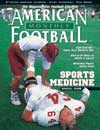AMERICAN FOOTBALL MONTHLY THE #1 RESOURCE FOR FOOTBALL COACHES
Article CategoriesAFM Magazine
|
Little on Size Big on Protectionby: Dan Brett, D.D.S© More from this issue Mouthpieces are one of the required and fundamental pieces of equipment of football. Yet, many coaches do not realize that there are more options than just "boil and bite". Despite this requirement, a study of Arizona High School coaches states that 53% of coaches polled believes that not all of their players wore mouthguards. This same study shows that 33% of these same coaches believe they have the greatest influence over compliance of their athletes. Yet, many coaches do not realize that there are more options than just "boil and bite". The purpose of this article is to help football coaches understand how mouthguards protect athletes, the types available, and the advantages and disadvantages of these types. Orofacial (face and mouth area) injuries were quite common (estimated at 50%) in football prior to 1973 when mouth....The full article can only be seen by subscribers. Subscribe today!
|
|
|||||||
| HOME |
MAGAZINE |
SUBSCRIBE | ONLINE COLUMNISTS | COACHING VIDEOS |
Copyright 2026, AmericanFootballMonthly.com
All Rights Reserved





